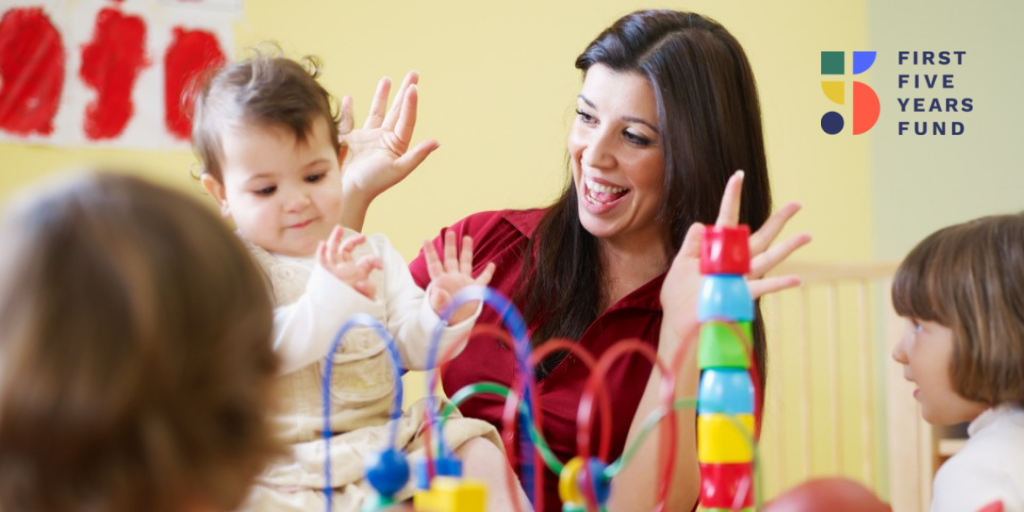How States Are Using PDG B-5 Building Grants to Improve Access to Child Care

The BUILD Initiative, ZERO TO THREE, and Start Early, recently released a new brief highlighting the strategies states are using to improve access to child care in their Preschool Development Grant Birth through Five (PDG B-5) Renewal applications. This brief highlights how PDG B-5 is being used to build the capacity of early care and education (ECE) systems, create infrastructure, provide direct services, and pilot new work in order to bolster child care availability. Their analysis found that states are employing different pilot programs and temporary strategies that are moving the needle in their states, but more federal funding is needed to ensure that they can see this work come to fruition and support young children and their families.
PDG B-5 is a competitive federal grant designed to improve states’ ECE systems. In 2023, 21 states were awarded Planning Grants, and 21 states were awarded Renewal Grants. While the scope of work for planning grantees is to conduct comprehensive needs assessments and draft strategic plans, the renewal grantees focus on implementing their strategic plan. The 21 renewal grantees are using this infusion of federal funding across a wide range of content areas in their ECE systems, and in a variety of ways, such as by implementing compensation reforms, expanding professional development training, building the supply of child care, and streamlining administrative requirements.
In analyzing PDG B-5 Renewal Grant applications, BUILD found that states have been charting their own course when it comes to ECE system development by working on a variety of projects and initiatives at once. They found that states tend to focus on shorter-term projects for their renewal grants, perhaps because states do not see PDG B-5 as a reliable, continuous funding stream and lack confidence that state funding would be available to sustain the work. States may also be focusing on producing near-term results, or the broad framework of the grant may have led to more responsive strategies.
Access to high-quality child care is proven to dramatically improve a child’s opportunities for a better future while offering parents improved job stability and overall economic security. However, families currently face a variety of barriers such as high costs, limited availability, and a scarcity of quality options available.
According to BUILD’s analysis, PDG B-5 Renewal plans were most likely to improve child care availability across five areas:
- Quality Enhancement and Access Expansion Grants
- Removal of Obstacles to Entry and Simplifying Administrative Procedures
- Increasing Public Awareness of Early Childhood Programs
- Collaborative Efforts to Boost Child Care Supply and Quality
- Expansion of Early Head Start/Child Care Partnerships
Within these five areas, BUILD found that states are adopting 18 strategies, such as expanding access, providing support and training to providers, creating family child care networks, developing comprehensive inventories of early childhood programs, and focusing on Early Head Start-Child Care Partnerships (EHS-CCPs), among many others. States are using PDG B-5 Renewal grants to recognize the important role of home-based child care, and other priorities such as expanding access to high-quality care for infants and toddlers, and building supply in rural areas and communities designed as “high need”.
PDG B-5 Renewal Grants provide an opportunity for states to create supportive, targeted strategies. Click here to read more about all of the strategies that states are pursuing and read on to see a few examples directly from BUILD of how states are using PDG B-5 renewal grant funds to improve access to child care.
Quality Enhancement and Access Expansion Grants
16 states recognized the importance of supporting and enhancing child care supply through the use of grants. There is a strong emphasis on supporting infants and toddlers, as well as enhancing care in high-need and rural areas.
- Using a needs assessment, Ohio will provide subgrants to expand access to targeting rural areas or increasing capacity to serve low-income children or infants and toddlers.
Removal of Obstacles to Entry and Simplifying Administrative Procedures
6 states focused on this area, pursuing strategies that enhance supports to providers to successfully navigate child care licensing systems and that leverage technology as a digital solution to mitigate administrative burden and create greater efficiencies for providers.
- Delaware is working to improve its online portal to decrease licensing monitors’ workload and eliminate duplicative processes.
Increasing Public Awareness of Early Childhood Programs
6 states are concentrating on initiatives that encourage collaboration, networking, and support for child care providers, with a specific focus on supporting home-based providers.
- Idaho is partnering with Wonderschool to develop a platform simplifying application, eligibility, and enrollment processes for families seeking home-based care, and to provide family child care providers with an online portal featuring support features for cost and revenue analysis.
Collaborative Efforts to Boost Child Care Supply and Quality
One state, Alaska, chose to focus on this area.
- Alaska is designing and implementing awareness campaigns, which focus on making comprehensive inventories of ECE programs accessible to the public, organized by community and by region. By boosting public awareness, Alaska aims to empower families to make well-informed decisions about their children’s education and ensure that a greater number of families can take advantage of high-quality ECE services.
Expansion of Early Head Start/Child Care Partnerships
Utilizing this strategy and leveraging existing federal funding, two states, Hawaii and Montana, are focusing on Early Head Start -Child Care Partnerships (EHS-CCP).
- Montana is building on its existing 14 EHS-CCP sites and 10 providers by offering stipends to licensed programs and EHSs currently participating in the partnership. These stipends will support continued participation, quarterly convening, and potential slot expansion, ensuring that more infants and toddlers from low-income families have access to high-quality child care services.
Throughout 2023, BUILD will continue to produce briefs highlighting how states are using PDG B-5 renewal grants, focusing on the following strategies: Workforce Compensation, Systems Building through Governance Processes, Ensuring Access for All Children: Inclusion, Supporting Multilingual Learners, Career Pathways, Mixed Delivery Systems, and Financing.
This is part of a larger blog series, find the rest of our PDG series here.
Subscribe to FFYF First Look
Every morning, FFYF reports on the latest child care & early learning news from across the country. Subscribe and take 5 minutes to know what's happening in early childhood education.


